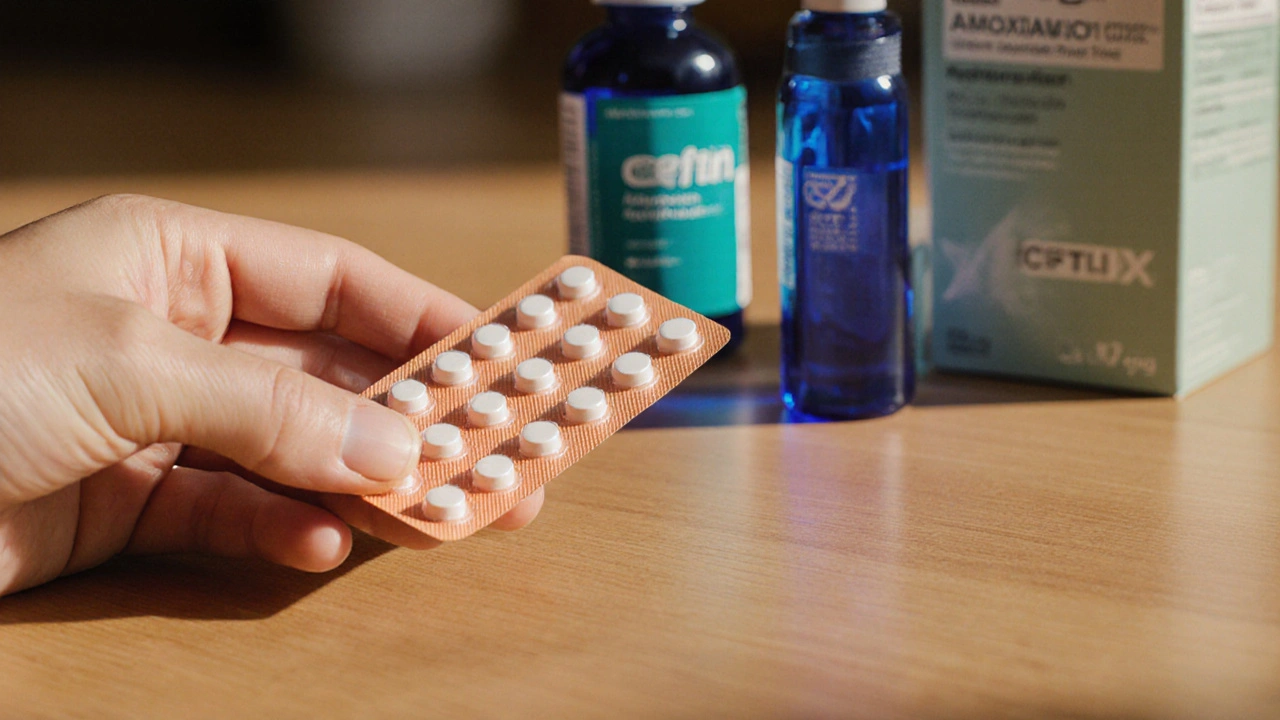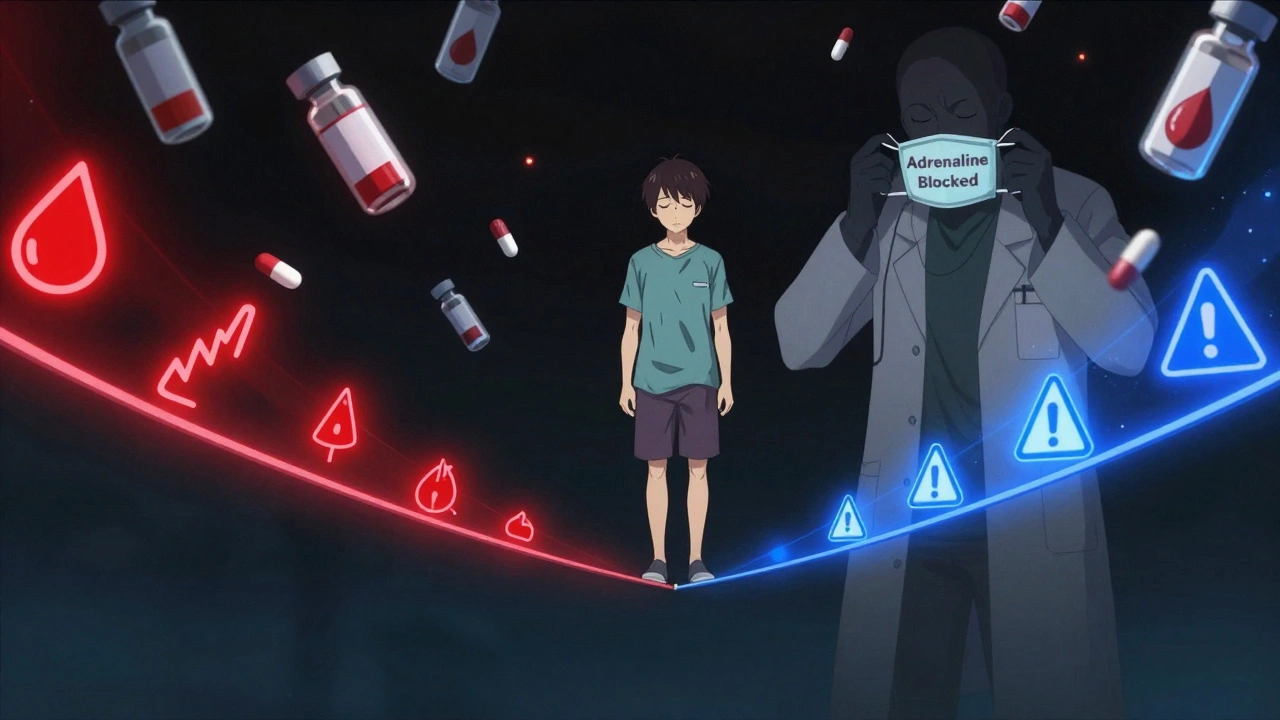Ceftin (Cefuroxime) vs Other Antibiotics: Detailed Comparison and Alternatives

Ceftin vs. Antibiotic Alternatives: Interactive Comparison Tool
Ceftin (Cefuroxime)
2nd-gen CephalosporinSpectrum: Gram-positive & Gram-negative
Dosing: 250-500 mg q12h
Cost: $30-45
Amoxicillin
PenicillinSpectrum: Gram-positive, limited Gram-negative
Dosing: 500 mg t.i.d. or 875 mg b.i.d.
Cost: $10-20
Azithromycin
MacrolideSpectrum: Broad, good intracellular
Dosing: 500 mg day 1, then 250 mg daily x4
Cost: $25-35
Doxycycline
TetracyclineSpectrum: Broad, atypical organisms
Dosing: 100 mg b.i.d.
Cost: $15-25
Cefpodoxime
3rd-gen CephalosporinSpectrum: Enhanced Gram-negative
Dosing: 200 mg b.i.d.
Cost: $40-55
Ceftriaxone
3rd-gen Cephalosporin (Injectable)Spectrum: Very broad Gram-negative
Dosing: 1-2 g once daily
Cost: $80-120
Comparison Criteria
- Spectrum of Activity Ceftin: Both Gram+
- Dosing Convenience Ceftin: Twice daily
- Safety Profile Ceftin: GI upset, rash
- Resistance Trends Ceftin: Beta-lactamase concern
- Cost & Availability Ceftin: $30-45 (PBS subsidized)
- Use Ceftin for middle ear infections or uncomplicated UTIs
- Consider Amoxicillin for cheaper, penicillin-allergic patients
- Try Azithromycin for once-daily dosing and respiratory infections
- Choose Doxycycline for atypical organisms or travel-related issues
- Select Cefpodoxime for enhanced Gram-negative coverage
When a doctor prescribes an antibiotic, patients often wonder whether that drug is the best fit for their infection. Ceftin is the brand name for cefuroxime, a second‑generation cephalosporin used for ear, throat, sinus, urinary‑tract and skin infections. But there are plenty of other options-some cheaper, some broader‑spectrum, some with fewer side effects. This guide breaks down how Ceftin stacks up against the most common alternatives so you can have a clearer picture before you fill a prescription.
Quick Take
- Ceftin is a second‑generation cephalosporin, strong against gram‑positive and many gram‑negative bacteria.
- Amoxicillin is cheaper and works well for many upper‑respiratory infections, but misses some resistant strains.
- Azithromycin offers once‑daily dosing and good tissue penetration, yet resistance is rising in many regions.
- Doxycycline is a tetracycline that covers atypical bugs and is useful for travel‑related infections.
- Cefpodoxime and ceftriaxone are third‑generation cephalosporins with broader gram‑negative coverage but higher cost.
What Is Ceftin (Cefuroxime)?
Cefuroxime is a second‑generation cephalosporin antibiotic that inhibits bacterial cell‑wall synthesis. It’s available as oral tablets (250mg, 500mg) and as an injectable (intravenous or intramuscular). Typical adult dosing for uncomplicated infections is 250mg every 12hours, or 500mg every 12hours for more severe cases.
Key pharmacologic facts:
- Bioavailability: ~50% for the oral form.
- Half‑life: 1-1.5hours (renal elimination).
- Common side effects: diarrhea, nausea, rash, and rare allergic reactions.
- Resistance concerns: beta‑lactamase‑producing organisms may reduce effectiveness.
How to Compare Antibiotics - Decision Criteria
Choosing the right antibiotic isn’t just about brand name. Look at these five criteria, which we’ll apply to each alternative.
- Spectrum of activity - which bacteria the drug can kill.
- Dosing convenience - number of pills per day, need for injections.
- Safety profile - side‑effects, drug‑interactions, allergy risk.
- Resistance trends - how common resistant strains are in your area.
- Cost and availability - price per course and whether it’s on the PBS (Australia) or private script.
Comparison Table: Ceftin and Five Popular Alternatives
| Antibiotic | Class | Typical Adult Dose | Spectrum (Gram‑) | Key Side Effects | Typical Cost (AU$) per 7‑day Course |
|---|---|---|---|---|---|
| Ceftin (Cefuroxime) | 2nd‑gen Cephalosporin | 250mg q12h (or 500mg q12h) | Both Gram‑positive & Gram‑negative (incl. H. influenzae) | GI upset, rash, rare C.difficile | ≈$30-$45 |
| Amoxicillin | Penicillin | 500mg t.i.d. or 875mg b.i.d. | Strong Gram‑positive, limited Gram‑negative | Diarrhea, allergic rash | ≈$10-$20 |
| Azithromycin | Macrolide | 500mg day1, then 250mg daily x4 | Broad, good intracellular coverage | GI upset, QT prolongation | ≈$25-$35 |
| Doxycycline | Tetracycline | 100mg b.i.d. | Broad, including atypical & some Gram‑negative | Photosensitivity, esophagitis | ≈$15-$25 |
| Cefpodoxime | 3rd‑gen Cephalosporin | 200mg b.i.d. | Enhanced Gram‑negative, some ESBL coverage | Diarrhea, rash | ≈$40-$55 |
| Ceftriaxone | 3rd‑gen Cephalosporin (injectable) | 1-2g IV/IM once daily | Very broad gram‑negative, some gram‑positive | Injection site pain, biliary sludging | ≈$80-$120 |

Deep Dive: The Five Most Common Alternatives
Amoxicillin
Amoxicillin is a penicillin‑type antibiotic that works by disrupting bacterial cell‑wall synthesis. It’s often the first‑line choice for uncomplicated sinusitis, otitis media and strep throat because it’s cheap, well‑tolerated, and has a solid safety record. However, its gram‑negative coverage is limited, and many community‑acquired strains now produce beta‑lactamase, rendering amoxicillin ineffective unless paired with clavulanic acid.
Azithromycin
Azithromycin belongs to the macrolide class and inhibits bacterial protein synthesis. The “Z‑pack” regimen (single high dose then lower doses) makes it popular for patients who dislike multiple pills per day. It penetrates lung tissue well, so it’s used for atypical pneumonia. The downside? Rising macrolide resistance, especially in Streptococcus pneumoniae and Haemophilus influenzae, reduces its reliability for standard respiratory infections.
Doxycycline
Doxycycline is a broad‑spectrum tetracycline that blocks protein synthesis. It’s a go‑to for travel‑related diarrhoea, acne, and tick‑borne illnesses like Lyme disease. Its advantage is coverage of atypical organisms (e.g., Mycoplasma, Chlamydia). Careful with sun exposure - photosensitivity is common - and it should not be given to pregnant women or children under eight.
Cefpodoxime
Cefpodoxime is a third‑generation cephalosporin taken orally. It offers stronger gram‑negative activity than Ceftin, including some Enterobacteriaceae, and maintains good activity against H. influenzae. It’s more expensive and requires twice‑daily dosing, but it can be a better option for infections where gram‑negative coverage is crucial, like complicated urinary‑tract infections.
Ceftriaxone
Ceftriaxone is an injectable third‑generation cephalosporin with a very long half‑life. A single daily dose can treat severe pneumonia, meningitis, and gonorrhea. Because it’s given by IV or IM, it’s usually reserved for hospital settings or when oral therapy fails. High cost and the need for professional administration limit its use in routine outpatient care.
When Is Ceftin the Right Choice?
If your infection is caused by bacteria that are known to be susceptible to second‑generation cephalosporins-like many strains of Streptococcus pneumoniae, Haemophilus influenzae, or Moraxella catarrhalis-Ceftin offers a balanced spectrum without the broader‑spectrum side effects of third‑generation drugs. It’s also a decent fallback when a patient is allergic to penicillins but can tolerate cephalosporins.
Key scenarios where Ceftin shines:
- Middle ear infections (otitis media) in adults where penicillin allergy limits options. \n
- Uncomplicated urinary‑tract infections caused by susceptible E.coli.
- Skin and soft‑tissue infections where MRSA is not a concern.
- Patients needing a twice‑daily oral regimen (more convenient than t.i.d. amoxicillin).
How to Talk to Your Pharmacist or Doctor
Bring these points to the consultation:
- Ask whether the pathogen is likely to be beta‑lactamase‑producing.
- Confirm any known drug allergies-especially to penicillins or other cephalosporins.
- Discuss dosing convenience-if you forget doses, a once‑daily drug may be safer.
- Inquire about PBS subsidy: Ceftin is listed for certain indications, which can lower out‑of‑pocket cost.
Frequently Asked Questions
Can I take Ceftin if I’m allergic to penicillin?
Most people with a mild penicillin allergy can tolerate cephalosporins like Ceftin, but severe IgE‑mediated reactions increase cross‑reactivity risk. Always tell your doctor about any allergy history.
Is Ceftin effective for COVID‑19‑related bacterial pneumonia?
Ceftin treats bacterial pneumonia, not viral COVID‑19. It may be added if a secondary bacterial infection is confirmed or strongly suspected.
How long does a typical Ceftin course last?
For most acute infections, a 7‑day course is standard, but doctors may extend to 10-14 days for more serious or complicated cases.
Can I take Ceftin with antacids?
Yes, Ceftin’s absorption isn’t significantly affected by antacids, unlike some other cephalosporins. Still, space them an hour apart for best results.
What should I do if I miss a dose?
Take the missed dose as soon as you remember, unless it’s almost time for the next dose. In that case, skip the missed one-don’t double up.
Next Steps If You’re Unsure
Start by noting the infection type, symptoms duration, and any known drug allergies. Bring that list to your GP or pharmacist. If they suggest Ceftin, ask about the exact dosing schedule, expected side effects, and whether the prescription is PBS‑subsidised.
If cost or dosing frequency is a barrier, compare the figures in the table above-often amoxicillin or doxycycline can be cheaper while still effective, depending on the bug.
Should you experience severe diarrhea, rash, or breathing difficulty while on any antibiotic, stop the medication and seek medical attention immediately.
Choosing the right antibiotic is a balance of effectiveness, safety, convenience, and price. By understanding where Ceftin fits among its peers, you can have a more informed conversation with your healthcare provider and feel confident about the treatment plan.






Comments
Ryan Hlavaty
October 3, 2025 AT 19:00It’s astonishing how often people prescribe Ceftin without considering the broader impact on antibiotic resistance. We have a moral duty to reserve broad‑spectrum agents for truly indicated cases. Choosing a cheaper, narrower drug like amoxicillin when appropriate is not just economical-it’s ethically responsible. Overuse of second‑generation cephalosporins fuels the beta‑lactamase problem we all dread.
aura green
October 3, 2025 AT 21:13Wow, what a dazzling parade of options we have for battling our microscopic foes! 😁 From the humble amoxicillin to the mighty ceftriaxone, each drug brings its own charm and price tag. If you love paying extra for the thrill of a third‑generation cephalosporin, go ahead and splurge-your wallet will thank you later. Meanwhile, Ceftin sits comfortably in the middle, not too cheap and not too pricey, like the Goldilocks of antibiotics. The dosing schedule is a simple twice‑daily routine, which means you won’t forget a dose if you’re juggling a chaotic life. And let’s not forget the side‑effects: a dash of diarrhea, a sprinkle of rash-just enough to keep you humble. 😏 The table in the article beautifully lays out the costs, so you can make an informed decision without having to decipher cryptic pharmacy receipts. In the grand scheme, picking the right antibiotic is like choosing the right tool for a job; you wouldn’t use a sledgehammer to fix a watch, right? So, consider the infection type, your budget, and maybe your doctor’s favorite brand before you click “order.” Finally, remember that the PBS subsidy can make Ceftin a sweet deal if you qualify-multiple wins! 🌟
Edward Morrow
October 3, 2025 AT 23:26Listen up, folks-if you’re still reaching for that cheap amoxicillin for every cough, you’re basically cheering for the germ army. Ceftin’s got the swagger of a second‑gen cephalosporin, taking on gram‑negatives that your penicillin‑loving buddy can’t touch. And don’t even get me started on those macrolides; they’re losing the battle faster than a meme on a dead subreddit. Choose wisely, or you’ll be the poster child for antibiotic failure.
Shayne Tremblay
October 4, 2025 AT 01:40Great breakdown! Let’s remember that staying motivated with the right antibiotic can speed up recovery and keep morale high. If you’re unsure, talk to your pharmacist-they’ll help you match the drug to your infection profile. Keep pushing forward, and don’t let the jargon discourage you.
Stephen Richter
October 4, 2025 AT 03:53Considering the pharmacokinetic profile, Ceftin presents a balanced efficacy. The dosing regimen remains straightforward.
Musa Bwanali
October 4, 2025 AT 06:06Spot on with the pharmacology note. When the infection is moderate, Ceftin offers a solid middle ground without the expense of third‑generation agents. Just ensure renal function is monitored if you’re on the higher dose.
Allison Sprague
October 4, 2025 AT 08:20The article does a decent job, but it could tighten up a few grammatical slips. For instance, “patients often wonder whether that drug is the best fit” should be “whether the drug is the best fit.” Also, the term “beta‑lactamase concern” feels vague; specify the prevalence of resistant strains. Accuracy matters, especially in medical writing.
leo calzoni
October 4, 2025 AT 10:33While the table is informative, one must acknowledge that the cost ranges are approximations; regional pricing can vary dramatically.
Robert Jaskowiak
October 4, 2025 AT 12:46Appreciate the thorough comparison-especially the side‑effect profiles. It’s easy to overlook that Ceftin’s GI upset is less severe than the clostridioides risk of broader cephalosporins. Also, the convenience of twice‑daily dosing can improve adherence for busy patients. Keep the balance between spectrum and stewardship in mind.
Julia Gonchar
October 4, 2025 AT 15:00From a pharmacodynamic standpoint, Ceftin’s half‑life justifies a q12h schedule, unlike doxycycline’s longer interval. The cost‑effectiveness is evident when the infection is susceptible.
Annie Crumbaugh
October 4, 2025 AT 17:13Nice overview. It’s helpful to see the dosing side by side.
Vic Harry
October 4, 2025 AT 19:26America’s best antibiotics are the cheap ones.
Suman Wagle
October 4, 2025 AT 21:40Reading this, I can’t help but chuckle at the sheer number of options-like a buffet of bacterial warfare. Still, the sarcasm of “once‑daily dosing is convenient” feels a tad misplaced when compliance is often the bigger hurdle. On a serious note, the suggestion to discuss beta‑lactamase production with your doctor is gold; it steers the conversation toward targeted therapy. Keep the optimism, but remember the reality of resistance trends.
Neil Sheppeck
October 4, 2025 AT 23:53It’s wonderful to see a balanced view that respects both efficacy and stewardship. By highlighting scenarios where Ceftin shines, we empower patients to ask informed questions. Let’s keep fostering an inclusive dialogue that welcomes diverse perspectives on antibiotic use.
Stephanie S
October 5, 2025 AT 02:06Indeed, the nuances of cost, spectrum, and patient preference intertwine beautifully; each factor deserves careful consideration, especially when prescribing. Moreover, discussing PBS subsidies can alleviate financial burdens, which is a critical yet often overlooked aspect. Let’s continue to share such comprehensive insights, ensuring that both clinicians and patients feel well‑supported.
Bradley Fenton
October 5, 2025 AT 04:20Ceftin offers a decent middle ground; it’s not too broad, not too narrow. Check renal function before dosing.
Wayne Corlis
October 5, 2025 AT 06:33Ah, the grand theatre of antibiotics-where each drug plays its part on the microscopic stage, and we, the baffled audience, are left to decipher the script. One could argue that Ceftin, perched somewhere between the modest amoxicillin and the flamboyant ceftriaxone, embodies the very essence of ambivalence. It whispers promises of “both gram‑positive and gram‑negative coverage,” yet mutters about beta‑lactamase concerns, as if fearing the shadows of resistance. The dosing schedule, a tidy twice‑daily ritual, suggests a modest convenience, but then the side‑effects-diarrhea, rash, the occasional C. difficile-sneak in like uninvited guests. When you compare costs, you see the middle‑priced bracket of $30‑45, a sweet spot that teases both frugality and extravagance. The article’s table, with its rows of names, reads like a roster of contenders in a bacterial battle royale, each wielding its own spectrum sword. Amoxicillin, the underdog, boasts cheapness and a familiar face, yet falters against the beta‑lactamase armies. Azithromycin struts with once‑daily dosing, a siren for the lazy, but its rising resistance makes it a treacherous ally. Doxycycline, the adventurous traveler, covers atypical bugs and sun‑sensitive skin, a double‑edged sword indeed. Cefpodoxime and ceftriaxone flaunt their third‑generation swagger, demanding higher price tags and, in the case of ceftriaxone, a clinical injection-a reminder that power often comes with a price. The decision tips, like a seesaw, balance between spectrum breadth, safety, convenience, resistance trends, and wallet strain. The author’s advice, peppered with “when to choose Ceftin,” feels like a gentle nudge rather than a command, respecting patient autonomy. Yet, beneath the calm prose lies an undercurrent of urgency: choose wisely, lest we feed the ever‑growing beast of antimicrobial resistance. In the end, the true hero is not the drug, but the informed patient and the vigilant clinician, navigating this labyrinth together. So, dear reader, arm yourself with knowledge, question the prescription, and remember: the best antibiotic is the one you don’t need.